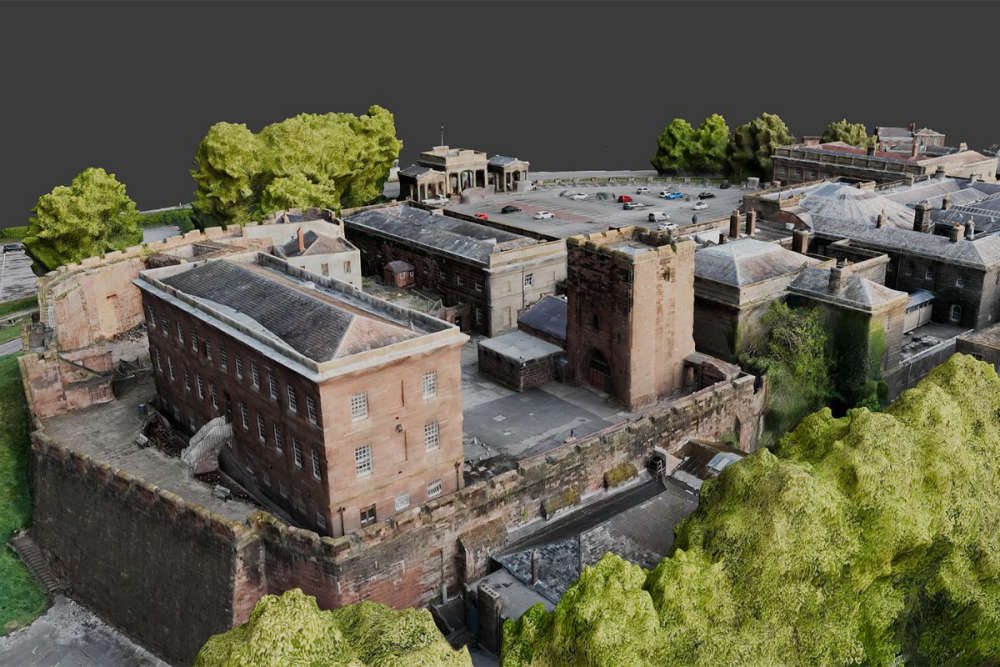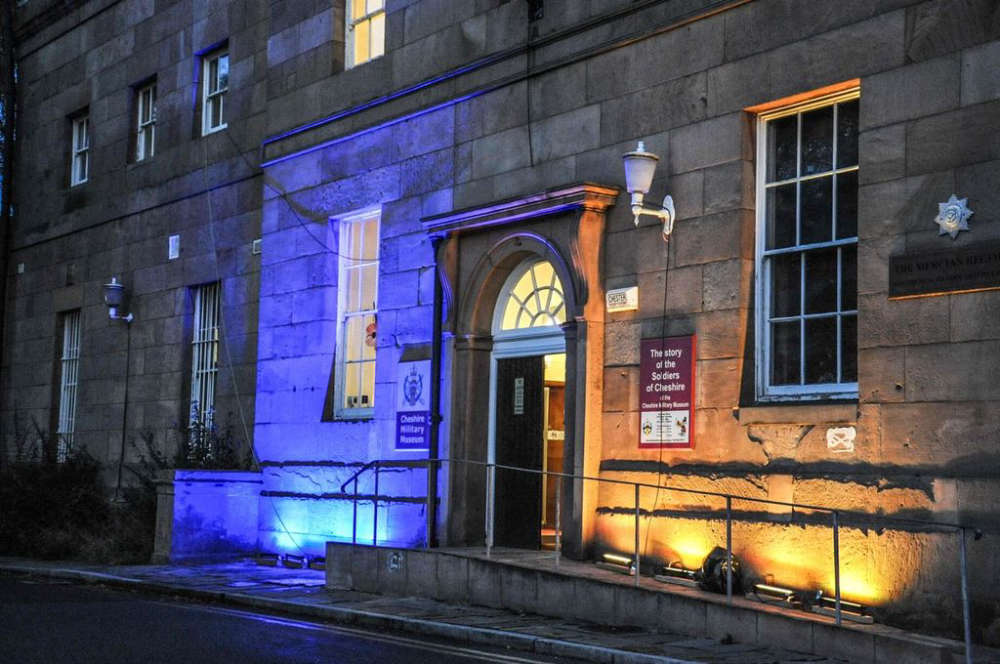
A project to capture an iconic Chester city centre landmark in new levels of detail with the help of a Time Team expert could help combat heritage crime.
The ground-breaking Digital Dimensions Project at Chester Castle, led by University of Chester team Stewart Ainsworth (Time Team’s Landscape Archaeologist and Visiting Professor of Landscape Archaeology), Professor Meggen Gondek and Alex Foster (Digital Specialist), brings together representatives, resources and skills from the University, English Heritage, Historic England and Cheshire Police Rural Crime Team.
The project could shed new light on Chester Castle’s origins and lead to the innovative methods being used more widely at other heritage sites to promote conservation and limit heritage crime. Some of the digital models and imagery can also be displayed more widely for the benefit of students and schools, while also promoting wider outreach opportunities for digital exploration of the castle via the internet and English Heritage.
It uses latest-generation drones with light detection and ranging data (LIDAR) and imaging sensors to generate a survey of the whole castle complex. Additionally, there will be targeted surveys of areas of specific archaeological and/or architectural interest for more detailed scanning to generate 3D models and images in detail never seen before.
Such methods allow a detailed survey and analysis to be undertaken in a non-invasive way, thereby recording and preserving the castle complex without damaging any of the structures. The analysis of the results will help contribute to its long and complex history through its many physical changes over the centuries, as well as inform conservation and preservation of its structures.
This new project builds upon pioneering work undertaken by Stewart and colleagues from the University in 2024, in a collaboration with Forestry England and Historic England, using LIDAR and other remote-sensing techniques to investigate a scheduled medieval glassworks at Glaziers’ Hollow in Delamere Forest, which is on the Heritage at Risk Register.
Following that work at Delamere and other sites in Shropshire, Stewart was approached by Cheshire Police Rural Crime Team to see if the methods used to document the landscape could record and investigate damage or threats to heritage assets elsewhere. Use of the drones and scanners would allow remote-sensing surveys to be carried out and generate a snapshot of what heritage assets look like at a particular point in time, making it easier to detect any unwarranted changes such as theft and/or vandalism.
New methods of analysing the impact of damage to assets are also being evaluated as part of this project. This is particularly relevant in the wake of the widely reported Sycamore Gap crime which has highlighted the value placed on cultural assets.
Stewart said:
“Chester Castle has been a centre of regional power, justice and administration for centuries, yet it remains one of the city’s least understood heritage assets. This new collaborative project will not only benefit Chester, it will also make it known to a much wider audience through the power of digital outreach, as well as contributing to the protection of other cultural assets.”
The University research project is complementing survey work already undertaken by Historic England at the Agricola Tower, where the High Sheriff of Cheshire, Joëlle Warren MBE, visited to learn about the exciting developments.
The High Sheriff said:
“On a recent visit to Chester Castle, I met with Cheshire Police, English Heritage and the University of Chester who are working together to tackle combat heritage crime using leading-edge 3D imaging software. It’s always exciting to see true collaboration between organisations and the difference this can make in our community.”
Win Scutt, Curator of Properties at English Heritage, said:
"Chester Castle stands as a pivotal monument in medieval English history, serving as a key Norman stronghold, administrative centre for the Earldom of Chester, and a crucial military base for campaigns against Wales.
“The ongoing digital scanning and research are of immense importance, as they allow for the creation of incredibly precise 3D models and detailed documentation, safeguarding this invaluable heritage for future generations and enabling unprecedented opportunities for conservation, study, and public engagement."
PC Jonathan Lightfoot, Heritage Crime Officer and Wildlife Crime Officer for Cheshire Police Rural Crime Team, added:
“This is a fantastic opportunity to see what modern technology can be used to both detect and prevent heritage crime.
“Being able to have 3D models and maps of crime scenes can really assist use with investigations. We have already seen what evidence can be produced from some of the tests we have done and it is really exciting.”
Pictured - 3D scans generated of the Chester Castle area.


 Calls to end corridor care in NHS Wales
Calls to end corridor care in NHS Wales
 NEW SPECIAL EXHIBITION: ‘Ukraine’ at the Cheshire Military Museum
NEW SPECIAL EXHIBITION: ‘Ukraine’ at the Cheshire Military Museum
 Council uses powers to close shops selling illegal vapes and tobacco products
Council uses powers to close shops selling illegal vapes and tobacco products
 Public consultation on the future of public toilets at Holywell, Mold and Talacre
Public consultation on the future of public toilets at Holywell, Mold and Talacre
 Man jailed for 16 years after being found guilty of rape
Man jailed for 16 years after being found guilty of rape
 Ellesmere Port community projects awarded share of Police and Crime Commissioner’s £150k fund
Ellesmere Port community projects awarded share of Police and Crime Commissioner’s £150k fund
 Chester community projects awarded share of Police and Crime Commissioner’s £150k fund
Chester community projects awarded share of Police and Crime Commissioner’s £150k fund
 Council completes chewing gum cleaning project
Council completes chewing gum cleaning project
 Chester Market celebrates three years of success
Chester Market celebrates three years of success
 Chester and Wirral Football League - Latest Results
Chester and Wirral Football League - Latest Results
 Blues Match Report: Chester FC 1 - 1 Marine
Blues Match Report: Chester FC 1 - 1 Marine
 Wanted man from Ellesmere Port arrested and charged
Wanted man from Ellesmere Port arrested and charged
 'Winter Warmer' initiative for local over 60’s in North Wales
'Winter Warmer' initiative for local over 60’s in North Wales
 Inaugural meeting of the Cheshire and Warrington Combined Authority Shadow Board
Inaugural meeting of the Cheshire and Warrington Combined Authority Shadow Board
 Cheetah brothers arrive at Chester Zoo
Cheetah brothers arrive at Chester Zoo
 Ex-Chester FC star helps create stunning poppy tribute
Ex-Chester FC star helps create stunning poppy tribute
 FREE CHESTER CONCERT SET TO CELEBRATE WORK OF RENOWNED NORTH WEST BASED COMPOSER
FREE CHESTER CONCERT SET TO CELEBRATE WORK OF RENOWNED NORTH WEST BASED COMPOSER
 MUSIC BY RENOWNED WELSH FEMALE COMPOSER TO FEATURE IN WREXHAM ORCHESTRA REMEMBRANCE CONCERT
MUSIC BY RENOWNED WELSH FEMALE COMPOSER TO FEATURE IN WREXHAM ORCHESTRA REMEMBRANCE CONCERT
 Blues Match Report: Cambridge United 3 - 0 Chester FC
Blues Match Report: Cambridge United 3 - 0 Chester FC
 Blues Match Preview: Cambridge United v Chester FC
Blues Match Preview: Cambridge United v Chester FC
Comments
Add a comment